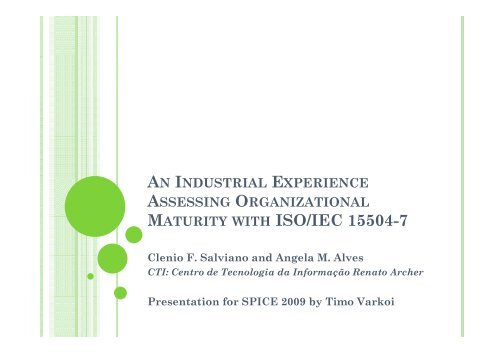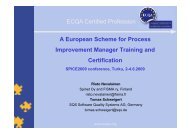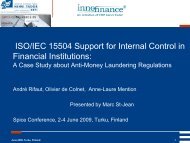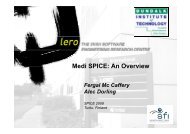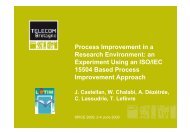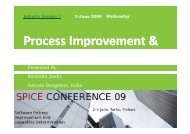aie ma iso/iec 15504 7 maturity with iso/iec 15504-7
aie ma iso/iec 15504 7 maturity with iso/iec 15504-7
aie ma iso/iec 15504 7 maturity with iso/iec 15504-7
You also want an ePaper? Increase the reach of your titles
YUMPU automatically turns print PDFs into web optimized ePapers that Google loves.
AAN IINDUSTRIAL EEXPERIENCE<br />
ASSESSING ORGANIZATIONAL<br />
MA MATURITY WITH ISO/IEC <strong>15504</strong> <strong>15504</strong>-77<br />
Clenio F. F Salviano and Angela M. M Alves<br />
CTI: Centro de Tecnologia da Infor<strong>ma</strong>ção Renato Archer<br />
Presentation for SPICE 2009 by Timo Varkoi
INTRODUCTION<br />
A workshop k h in i a software ft intensive i t i to t adopt d t<br />
CMMI-DEV<br />
Workshop Objectives<br />
understand the organization business goals,<br />
analyze the current state of the processes,<br />
produce an esti<strong>ma</strong>tion about the degree of<br />
satisfaction of the current process regards the CMMI-<br />
DEV V <strong>ma</strong>turity a y level eve 3, aand<br />
produce a general plan for a process improvement<br />
cycle to achieve the defined business goals using the<br />
CMMI-DEV <strong>ma</strong>turity level 33.<br />
Additional representation of the esti<strong>ma</strong>tion in<br />
terms of the recent ISO/IEC <strong>15504</strong>-7<br />
Organizational <strong>ma</strong>turity levels
ASSESSMENT PLANNING<br />
AAssessment t target: t t typical t i l successful f l l low <strong>ma</strong>turity t it<br />
organization – needs improvements<br />
PRO2PI (“Process ( Capability p y Profile to Process<br />
Improvement”)<br />
a methodology for process improvement driven by a Process<br />
Capability Profile model<br />
defines exploratory assessment as an assessment <strong>with</strong><br />
the objective to explore options to support process<br />
improvement in a s<strong>ma</strong>ll, low <strong>ma</strong>turity enterprise<br />
PRO2PI-WORK is a method for a workshop to<br />
establish a PRO2PI<br />
S CMMI DEV M i L l &<br />
Scope: CMMI-DEV Maturity Levels 2&3<br />
The assessment follows<br />
ARC C requirements<br />
ARC C requirements<br />
ISO/IEC <strong>15504</strong>-7 Class 3 requirements
ASSESSMENT RESULTS<br />
The result of the preliminary assessment,<br />
represented as CMMI-DEV Maturity Levels<br />
Th The esti<strong>ma</strong>tion ti ti is i that th t th the organizational i ti l unit it<br />
will satisfy about 30% of ML 2 and about 35% of<br />
ML 3<br />
Table 1 - Exploratory assessment results, presented by CMMI-DEV <strong>ma</strong>turity levels 2 and 3<br />
T.PA REQM PP PMC SAM M&A PPQA CM RD TS PI VER VAL OPF OPD OT IPM RSK<br />
#Pr.ML2 126 15 24 20 18 18 14 17<br />
S.Po.ML2 354 63 96 44 86 18 18 29<br />
est.ML2 31% 47% 44% 24% 53% 11% 14% 19%<br />
#Pr. ML3 356 17 26 22 20 20 16 19 22 20 21 20 17 21 18 19 21 19<br />
S.Po.ML3 1120 65 98 46 88 20 20 31 138 124 129 100 97 25 26 27 49 19<br />
est.ML3 35% 42% 42% 23% 49% 11% 14% 18% 70% 69% 68% 56% 63% 13% 16% 16% 26% 11%
ASSESSMENT RESULTS<br />
RResults lt <strong>ma</strong>y b be misleading i l di<br />
CMMI-DEV <strong>ma</strong>turity levels consider the engineering<br />
process areas, even <strong>with</strong> low capabilities, only from<br />
<strong>ma</strong>turity i level l l 3. 3<br />
This organization, however, has low capability good<br />
development engineering practices.<br />
An adjustment in the planning<br />
to include a representation of these results using an<br />
application pp of the ISO/IEC <strong>15504</strong>-7 Organizational<br />
g<br />
<strong>ma</strong>turity levels 1, 2 and 3 on the continuous representation<br />
of CMMI-DEV model<br />
The objective j of this decision was to produce p a better<br />
result.<br />
Process improvement point-of-view
ASSESSMENT RESULTS<br />
The result represented by CMMI-DEV <strong>15504</strong><br />
Organizational Maturity Levels<br />
Th The esti<strong>ma</strong>tion ti ti is i that th t th the organizational i ti l unit it<br />
will satisfy about 80% of OML 1, about 50% of<br />
OML 2 and about 35% of OML 3<br />
Table 1 - Exploratory assessment results, presented by <strong>15504</strong>-7 organizational <strong>ma</strong>turity levels 1, 2 and 3<br />
T.PA REQM PP PMC SAM M&A PPQA CM RD TS PI VER VAL OPF OPD OT IPM RSK<br />
#P #Pr.OML1 OML1 50 5 10 8 9 8 10<br />
S.Po.OML1 361 37 90 72 77 44 41<br />
est.OML1 80% 82% 100% 100% 95% 61% 46%<br />
#Pr. OML2 216 15 24 20 18 18 14 17 20 18 19 18 15<br />
S.Po.OML2 912 63 96 44 86 18 18 29 132 118 123 94 91<br />
est.OML2 47% 47% 44% 24% 53% 11% 14% 19% 73% 73% 72% 58% 67%<br />
#Pr. OML3 356 17 26 22 20 20 16 19 22 20 21 20 17 21 18 19 21 19<br />
SPoOML3 S.Po.OML3 1120 65 98 46 88 20 20 31 138 124 129 100 97 25 26 27 49 19<br />
est.OML3 35% 42% 42% 23% 49% 11% 14% 18% 70% 69% 68% 56% 63% 13% 16% 16% 26% 11%
CONCLUSION<br />
Based on this experience<br />
Exploratory assessment results using the ISO/IEC<br />
<strong>15504</strong> <strong>15504</strong>-7 7 Organizational <strong>ma</strong>turity levels 1, 1 2 and 3<br />
was better than the same results using the original<br />
CMMI-DEV <strong>ma</strong>turity levels 2 and 3, in terms of the<br />
communication i i about b the h current situation i i and d of f the h<br />
orientation for a improvement cycle.<br />
The evolution of the capability of engineering process<br />
areas, from level 1 to level 2 and then to level 3, is<br />
more explicitly in the ISO/IEC <strong>15504</strong>-7<br />
OOrganizational i ti l <strong>ma</strong>turity t it levels. l l<br />
This explicitly will help low <strong>ma</strong>turity organizations to<br />
understand better the path p to <strong>ma</strong>turity y<br />
level 3.


